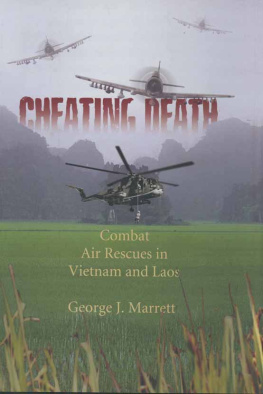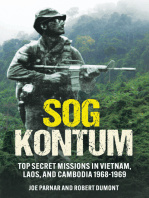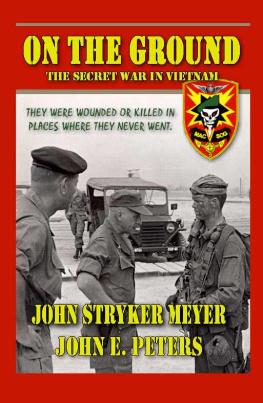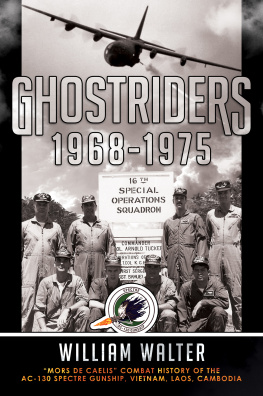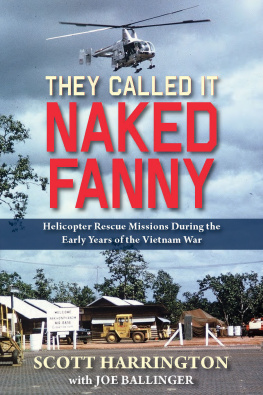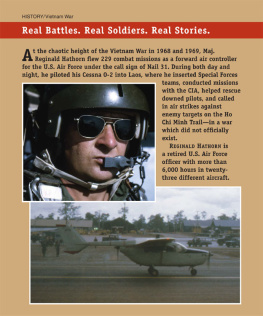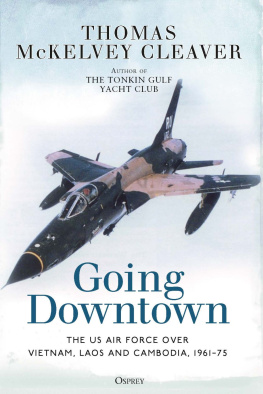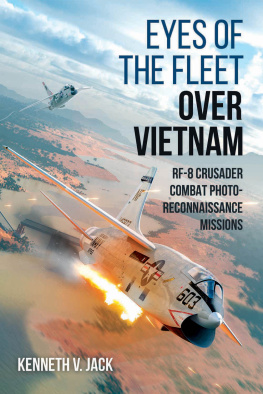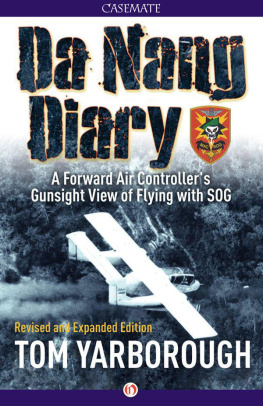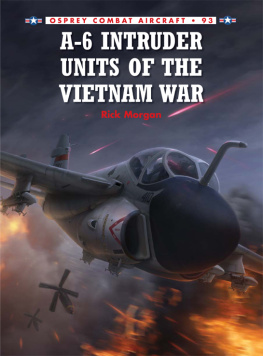First published in Great Britain in 2003 by
LEO COOPER
an imprint of Pen & Sword Books Ltd
47 Church Street,
Barnsley,
South Yorkshire
S70 2AS
In association with Smithsonian Books
George J. Marrett, 2003
All rights reserved. No part of this book may be
reproduced without written permission from
the publisher
ISBN 0 85052 972 7
A CIP record of this book is available from the British Library
Printed and bound in the USA
In
memory
of all the rescue crews,
especially the Skyraider pilots,
who paid the supreme price to rescue
American aviators shot down over Vietnam and Laos;
this book is dedicated to them
and to their
families.
Poor is the country that has no heroes, but beggared is
that people who, having them, forgets
quoted from an unknown source by A-1 Sandy pilot Col. William
A. Jones III, Maxims for Men-at-Arms
Special recognition and thanks go to my wife Jan for taking care of the home front while I was at war. She has also been my copilot for forty-four years and provided love, encouragement, and helpful suggestions as I brought these words to print. To my older son Randy, thanks for suggesting that I interrupt my test pilot writing to concentrate on completing my war memoirs. To my younger son Scott, who told Jan, Dad must have been the only pilot to eat as he flew on a combat mission, thanks for reading and reviewing these words.
I am deeply grateful to my father, George Rice Marrett, who taught me a sense of patriotism, and to my mother, Julia Etta (Rachuy) Marrett, who at age ninety-two has a wonderful memory. She taught me faith and persistence, traits I needed to both survive combat and to write this book.
To George Larson, senior editor of Air & Space magazine, thanks for recommending the Smithsonian Institution Press (SIP) for publication of my manuscript. SIP acquisitions editor Mark Gatlin, his assistant Nicole Sloan, and the staff of the press are a very professional organization and have been a joy to work with. Copy editor John Raymond has been extremely helpful in turning my pilot talk manuscript into a readable human-interest story.
I owe a great deal to Darrel D. Whitcomb, author of the book The Rescue of Bat 21 (Naval Institute Press, 1998), for encouraging me to write a first-person account of a Sandy rescue pilot at war and for reviewing the manuscript.
To Richard Hallion, Historian of the U.S. Air Force, thanks for having confidence that a pilot who had flown for forty-three years could transition from the cockpit to the typewriter.
William Forsyth, the Laotian specialist from the Joint Task Force-Full Accounting, located in Camp H. M. Smith, Hawaii, generously provided me with compass maps, SAR (search-and-rescue) logs, and results of government searches for missing airmen and crash sites in Laos.
In I relied heavily on information from Maj. Jimmy W. Kilbourne. I thank him for his generous permission to quote from and paraphrase some of his chapter about Col. William A. Jones III (Sandy One: Youre on Fire!) from his book Escape and Evasion (New York: Macmillan, 1973). Kilbournes chapter originally appeared in Airman magazine in the late 1960s.
I also wish to thank John L. Frisbee, contributing editor of Air Force online magazine (published by the Air Force Association), for permission to quote from his January 1986 story about Colonel Jones called A Triumph of Will.
The story in about my dead-stick landing in Laos was first published in a similar form in Wings magazine in April 2000. I wish to thank Wings for their permission to use it here.
I am grateful to Louie F. Alley, the Freedom of Information Act manager at the Headquarters Air Force Safety Center at Kirtland AFB, New Mexico, for providing releasable portions of Maj. Jerry J. Jenkinsons accident in the T-37B on December 17, 1969.
I wish to acknowledge Curly J. Putnam, author and publisher of The Green, Green Grass of Home, for the portion of his song quoted in .
In addition I wish to thank A-1 pilot Byron Hukee, who created and maintains the Web site: www.skyraiders.org.
The following individuals, some of whom provided photographs, kindly agreed to be interviewed for this publication: Gordon Breault (June 18, 2002), Bill Buice (March 24, 2001), Mel Bunn (April 1998), Tom Campbell (April 1998), John Carlson (April 1998), Don Dineen (April 1998), Don Dunaway (April 8, 2001), Harry Dunivant (April 3, 2001), Kenny Fields (April 1998), Ron Furtak (April 17, 2001), Jim George (April 28, 2001), Doug Horka (April 16, 2001), Don Johnson (July 21, 2001), Elizabeth Jones (April 8, 2001), Bob Kraus (March 11, 2001), Pete Lappin (April 1998), Fred Lentz (August 31, 2001), Ed Leonard (April 1998), Gene McCormack (April 19, 2001), John McMurtry (April 1998), Tom OConnor (April 18, 2001), Bill Palank (March 15, 2001), Dave Richardson (April 1998), Walt Steuck (March 31, 2001), Darryl Tripp (April 29, 2001), Wayne Warner (April 1, 2001), and Darrel Whitcomb (November 13, 2001).
Sometimes I still hear the call I made on the UHF (ultrahigh frequency) radio. It does not come to me in a dream, but its entrenched in my mind.
Sandy 7, this is 8.
I repeat it over and over.
Sandy 7, this is 8. Sandy 7, this is 8.
The guns are silent now, the Laotian jungle regrown and green. The American air warriors from the Vietnam era are back home again; that secret war is long over. Instead, the call must be a memory resounding in my head, a frantic call I repeat, echoing unanswered across all these years.
Tchepone was only a spot on a map, a tiny village near the intersection of dirt roads and a narrow river in central Laos. In the early evening of May 31, 1968, the men of the 602nd Fighter Squadron flew cautiously over that intersection. A short time earlier, a Navy Corsair A-7 attack jet from the carrier USS America had been shot down. A rescue force of four Sandy A-1 propeller-driven Skyraiders (Sandy was the call sign our squadron used for rescue missions) and two Jolly Green HH-3 jet helicopters (Jolly Greens had a specific call sign for each of their aircraft, JG 07, for example) arrived to extract the downed pilot from this enemy-infested area. The rescue force entered slowly. It was a clear, hot daythe sun beat down incessantly. The road below was hard packed from the thousands of North Vietnamese who carried arms and supplies southward over a route called the Ho Chi Minh Trail.
Leading the rescue force was Air Force Maj. William Palank and his wingman, Maj. Eugene McCormack Jr. The second flight of Skyraiders was led by Capt. Edward Leonard Jr., a combat veteran who had just completed a one-year tour but had extended for six more months. I was his wingman, a new guy, just three weeks from the States, flying my first rescue mission over unfamiliar country. Ed Leonard and I were escorting two of the Jolly Green helicopters to a safe areaawaiting the call from Bill Palank to attempt the rescue of Streetcar 304, Lt. Kenny W. Fields, the downed Navy pilot.
The men of the rescue force were hot, sweating profusely from the steaming jungle air. They wore survival vests, web belts with knife and pistol, helmets, oxygen masks, and glovesall their exposed skin was covered to protect them from the rigors of flight and perhaps the fear of the unknown that confronted them. A few miles to the east were the steep karst mountains of North Vietnam. Below was a winding river, a network of trails, and an American pilot in trouble.
The enemy, cool in their camouflaged trenches in the jungle, watched and waited. They could both see and hear the single-engine propeller aircraft that was orbiting overhead, looking for the missing airman. All at once the guns opened fire on the lead Sandy plane, striking the Skyraiders left wing and the huge Pratt & Whitney radial engine. Palank pushed his throttle full forward and climbed westward into the setting sun toward his home base, Nakhon Phanom (known to us as NKP), located about a hundred miles away across the Mekong River in friendly Thailand. I watched Palanks aircraft gradually disappear into the golden glow of approaching night, leaving a trail of smoke marking his route to safety.
Next page
